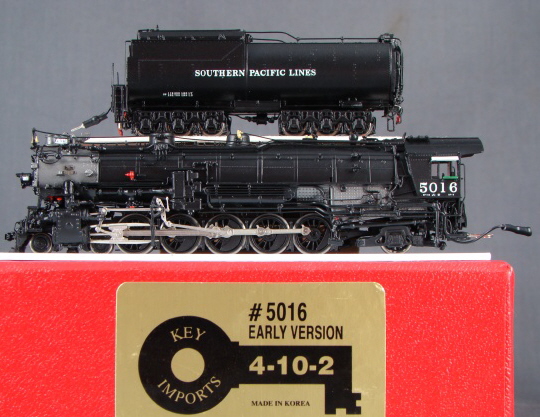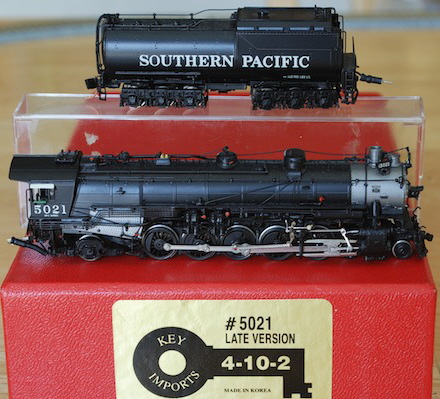

Introduced: 2006
As pictured at the bottom of the page, Key released two versions of this model - an "early" (1930s version) and a "late" (1950s version). Both are stunning looking models that feature exceptionally fine detailing (right down to the rope running from the cab to the bell).
The chassis is all metal, although it's also fairly minimalistic (with the shell providing most of the actual heft). Pickup is provided by the right-side drivers and the left-side tender wheels (and with the rest of the wheels being electrically neutral). Current is transferred from the tender to the locomotive via a single stiff wire on the drawbar. The coreless motor is mounted to a torque arm that connects to the gear box. The driveshaft is a multi-piece plastic affair that spins a worm inside said gear box. Only the center pair of drivers is geared (with the rest of the drivers being turned solely by the cranks). The driver axles ride inside of brass bearing blocks that seat inside cutouts in the frame. The pilot truck and tender trucks are sprung. Both the locomotive and tender feature directional lighting (the wiring for the latter sporting pin/socket connectors, allowing one to disconnect the engine from the tender). The headlight wiring runs through a weight that is jammed up inside the boiler (with the bulb on the other side), so replacing a burned out bulb looks to be damned near impossible. The wheels are low-profile, so no problems on Code-55 track. There are no traction tires. These can handle 15"-radius curves (or thereabouts), but anything sharper than that and derailing becomes a major problem.

Performance is just so so, with the main problem being the drawbar wiring (always a suspect way to get tender current to the motor). Even with nice clean wheels and track, mine tends to be pretty finicky about getting started. And once going, the headlight is constantly flickering as the tender current comes and goes. Also, the moving parts on mine tend to be a bit bindy, so slow speed creep is pretty poor. On the plus side, it does run extremely quietly.
The pilot truck spring is a bit feeble (putting very little downward pressure on the wheels). Also, the backup light wiring is kind of a nightmare (mainly due to the giant diode embedded inside of it). When I first got mine that diode was jammed up underneath the motor and causing all sorts of problems. Fortunately, Ron Bearden (noted brass locomotive doctor) was able to get that all cleaned up for me (he also fixed the pilot truck spring by adding another washer).
A common complaint with these models is that they are not strong pullers, however that was not my experience. Whereas others have reported that their models couldn't pull more than about ten 40' freight cars, mine had no problem pulling thirty such cars. As for why the wide discrepency? Sorry, your guess is as good as mine.
Overall, these models are a bit disappointing (at least as compared to some of Key's other brass steamers). And spotty current conductivity (vis'a'vis the tender drawbar) aside, it may very well be that trying to turn five sets of drivers with only one set of gears was a bridge too far design-wise. They sure do look great, though.


To remove the locomotive shell, first unscrew the two small screws at the back/bottom of the cab. Next, remove the pilot truck screw (and do be mindful of the "easily lost and never found" spring and washer combo). Once those three screws are removed, the shell should come off readily.
Grade: C (although adding a wire to the tender to improve pickup would probably raise this to a B)